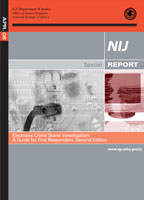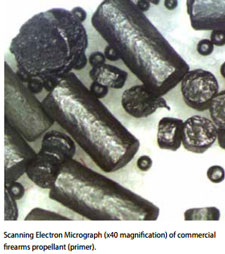|
View in browser: http://www.crime-scene-investigator.net/newsletter/0116.html
|
||
|
JANUARY 2016 | ||
|
Welcome to the January 2016 Crime Scene Investigator Network Newsletter
| ||
|
This Month's Featured Resource on the Crime Scene Investigator Network Website
|
||
 This guide is intended to assist State and local law enforcement and other first responders who may be responsible for preserving an electronic crime scene and for recognizing, collecting, and safeguarding digital evidence. It is not all inclusive but addresses situations encountered with electronic crime scenes and digital evidence. All crime scenes are unique and the judgment of the first responder, agency protocols, and prevailing technology should all be considered when implementing the information in this guide. First responders to electronic crime scenes should adjust their practices as circumstances—including level of experience, conditions, and available equipment—warrant. |
||
|
Featured Video Presentation
|
||
|
Learn the basic technique for processing latent fingerprints by dusting with black powder. |
||
|
New CSI and Forensic Job Announcements
|
||
|
The most comprehensive listing of Crime Scene Investigation and Forensic To be notified of job openings as they are posted, follow us on Twitter: Job Posting Alerts |
||
|
Forensic Technician (CSI)
City of Fayetteville Police Department, North Carolina, USA Final Filing Date: January 15, 2016 Responds to various types of crime and accident scenes, records detailed and accurate physical description of the scene, searches for, collects and preserves evidence, photographs the scene and evidence, and performs other documentation and evidence/scene processing as required. ... <View complete job listing> |
||
|
Crime Scene Technician
City of Peoria Police Department, Arizona, USA Final Filing Date: January 24, 2016 Responds to, examines and investigates crime scenes for the recognition, collection and preservation of physical evidence such as latent fingerprints, shoeprints, tire tracks, body fluids, hair and fibers, weapons and other materials; conducts presumptive field tests for blood and gun shot residue; attends autopsies as needed. Processes, analyzes, compares, evaluates and verifies latent and inked prints; authors and submits reports for all analysis and examinations. ... <View complete job listing> |
||
|
Forensic Scientist I — Firearm and Toolmark
Colorado Department of Public Safety, Lakewood, Colorado, USA Final Filing Date: January 18, 2016 This position is responsible for the preservation, analysis and interpretation of the physical evidence collected in criminal cases for federal, state and local law enforcement agencies. <View complete job listing> |
||
 |
||
|
Criminalist I
Honolulu Police Department, Oahu, Hawaii, USA Final Filing Date: January 14, 2016 Performs a variety of standard physical, chemical, instrumental, and microscopic analyses of evidence in connection with crime detection and law enforcement work; Assists with more complex investigations and studies, and with assigned phases of research projects; ... <View complete job listing> |
||
|
Fingerprint Examiner Supervisor
Mississippi Department of Public Safety, Rankin County, Mississippi, USA Final Filing Date: January 15, 2016 Provides direct line of supervision to the Fingerprint Identification Unit; delegates work and monitors the completion of work assigned to subordinates. Provides guidance and technical assistance and ensures work is performed according to legal guidelines and generally accepted practices. Processes fingerprints using electronic (Automated Fingerprint Identification System (AFIS)/LiveScan) or physical (ink fingerprinting) methods for the purpose of background investigations and licenses. ... <View complete job listing> |
||
|
Forensic Evidence Technician
Harris County Institute of Forensic Sciences, Houston, Texas, USA Final Filing Date: January 22, 2016 Receives and releases evidence from and to law enforcement and criminal justice system agencies using the approved protocols to preserve chain of custody. <View complete job listing> |
||
|
Search for more job listings in Crime Scene Investigations and Forensics To be notified of job openings as they are posted, follow us on Twitter: Job Posting Alerts |
||
|
CSI in the News
|
||
|
Berkeley Co. sheriff's department announces crime scene unit Local officials optimistic about locating forensic lab at UNA Investigators use digital forensic technology in 25-year-old cold case A battle online: Veterans sought to train in cyber investigations Washington state lab needs more money to clear rape kit backlog DNA evidence from air bag in hit-and-run crash leads to criminal charges |
||
|
Other Resources on the Crime Scene Investigator Network Website
|
||
|
Not Subscribed to this Newsletter?
|
||
|
If you are not subscribed to this newsletter, you may subscribe with this link: SUBSCRIBE via email |
||
|
To Unsubscribe
|
||
|
To unsubscribe from future e-mail newsletters, please click here: UNSUBSCRIBE Copyright ©2016 Crime Scene Resources, Inc. Crime Scene Investigator Network |




